|
|
|
photos: Jane Landers |
A panel that included Jim Rich, editor-in-chief of the Daily News, Priya Ganapati of Quartz and Kate Ward of Bustle.com considered the thorny issue of “branded content” or “sponsored” editorial matter that is seen by some media as one of the main answers to declining newspaper circulation and advertising.
|
|
Jay Rosen, journalism professor at New York University, moderated the program which is part a series of events called “Conversations”.
Rich said that in the past, newspapers were driven to build circulation. The goal is still building circulation but more attention is being paid to what types of audiences are being attracted, he said.
“Solid reporting, which includes great writing accompanied by great videos can still be a successful formula,” he said.
Ganapati said staffers at Quartz help advertisers create the most effective ads. Staffers think “holistically,” she said. “It is not just one person’s job to sell nor one person’s job to create content.”
Reporters Do More than "Gather Information"
|
|
Ward said that J students in college were taught to gather all information about a subject but now they have to learn to “navigate” when writing about a subject.
Journalists are challenged to “think more creatively,” she said. “Clients want premium product” which gives the medium “the opportunity to present product in a way that it has never before been presented.”
Bustle, founded in 2013 by Bryan Goldberg and which reaches an estimate audience of 40 million women monthly, is about “collaboration,” helping to build brands with the help of editors. The different departments of Bustle collaborate, she said. Bustle is part of the “community that it serves.” The “product team” at Bustle is also the “editorial team,” she said.
Rich noted that there are positions at the Daily News that did not previously exist such as “chief creative officer” and “product developer.” Members of such units must decide whose job it is to “cross the wall” that previously separated advertising and editorial.
The announcement for the panel had said: “As media companies increase their focus on business models, economic realities are affecting the way journalists work. Instead of a ‘strict separation’ between the business and editorial sides, journalists are being asked how they create value for the company that can be monetized, while still meeting their responsibilities to public service and truth telling.
"Acute Awareness" of Readers
Rich said there is an "acute awareness in the newsroom of what works for our readership."
Attendees asked whether it is advertising or consumers that failed the media and resulted in declining trust in media? Trust in mass media fell to 40% in 2015 from 55% in 1999 and from as high as 69% in 1974, according to Gallup. A chart in Quartz shows trust in media fell from 70% in 2005 among Democrats to 52% currently, and among Republicans, from 53% in 1998 to 12% currently. The average is around 30%.
Ward said that perhaps all parts of society are to blame. "We have to re-think how we do things," she said, adding there are now "a bunch of different opportunities." While Facebook is a "big driver of traffic," media should also utilize other platforms in social media and engage in partnerships where it benefits readers, she said.
Rich said media have failed to take up the challenges but "There's a lot of hope now...advertisers and consumers have more options." Interaction with readers is now a top goal of media, he said.
Moderator Jay Rosen said "The world changed and media have to change with it." Rich agreed.

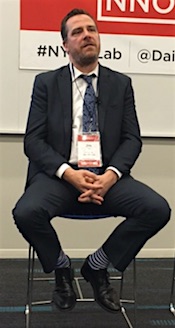
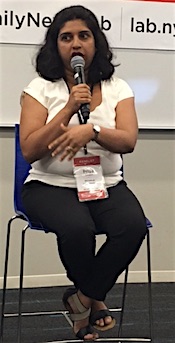
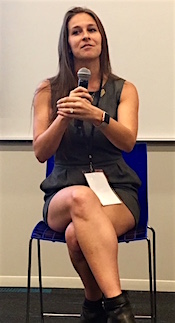

 Trump Media & Technology Group today reported a $58.2M net loss on $4.1M in 2023 revenues, a disclosure that drove its stock price down 22.6 percent to $47.96.
Trump Media & Technology Group today reported a $58.2M net loss on $4.1M in 2023 revenues, a disclosure that drove its stock price down 22.6 percent to $47.96. Barry Pollack, an attorney at Wall Street’s Harris St. Laurent & Wechsler, has registered Julian Assange as a client with the Justice Dept. “out of an abundance of caution.”
Barry Pollack, an attorney at Wall Street’s Harris St. Laurent & Wechsler, has registered Julian Assange as a client with the Justice Dept. “out of an abundance of caution.”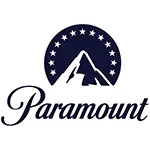 Paramount Global to slash 800 jobs in what chief executive Bob Bakish calls part of an effort to “return the company to earnings growth"... Rolling Stone editor-in-chief Noah Shachtman is exiting at the end of the month due to disagreements with chief executive Gus Wenner over the direction the magazine is taking... The New York Times broke the $1 billion barrier in annual revenue from digital subscriptions in 2023... Press Forward is investing more than $500 million to strengthen local newsrooms.
Paramount Global to slash 800 jobs in what chief executive Bob Bakish calls part of an effort to “return the company to earnings growth"... Rolling Stone editor-in-chief Noah Shachtman is exiting at the end of the month due to disagreements with chief executive Gus Wenner over the direction the magazine is taking... The New York Times broke the $1 billion barrier in annual revenue from digital subscriptions in 2023... Press Forward is investing more than $500 million to strengthen local newsrooms.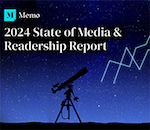 The majority of news articles are read within the first three days of publication, according to a recent report.
The majority of news articles are read within the first three days of publication, according to a recent report.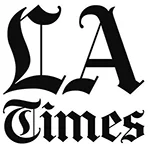 The Los Angeles Times gives pink slips to 115 people or 20 percent of its newsroom staff... TIME is also laying off about 30 employees, which is approximately 15 percent of its editorial staff... The Baltimore Banner, which was launched by Stewart Bainum in 2022 after he failed to buy the Baltimore Sun, added 500 subscribers per day in the three days following Sinclair Broadcast Group's deal to purchase the Sun.
The Los Angeles Times gives pink slips to 115 people or 20 percent of its newsroom staff... TIME is also laying off about 30 employees, which is approximately 15 percent of its editorial staff... The Baltimore Banner, which was launched by Stewart Bainum in 2022 after he failed to buy the Baltimore Sun, added 500 subscribers per day in the three days following Sinclair Broadcast Group's deal to purchase the Sun.


 Have a comment? Send it to
Have a comment? Send it to 
No comments have been submitted for this story yet.